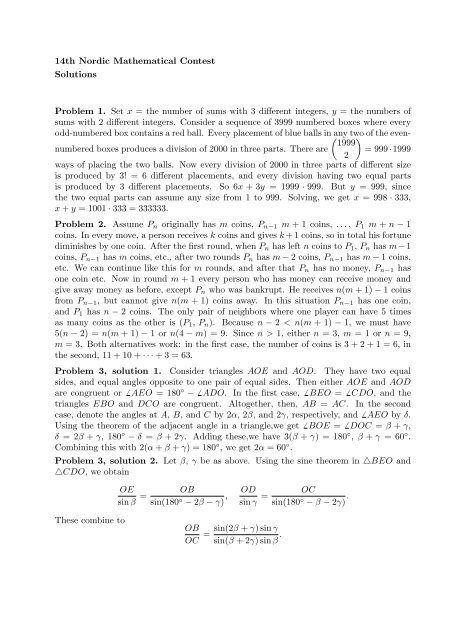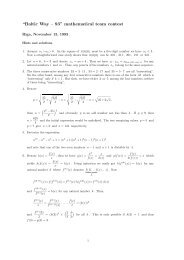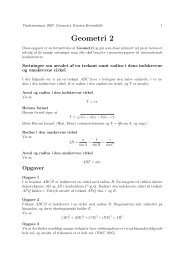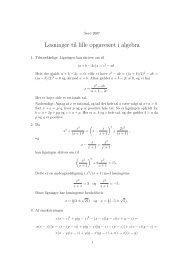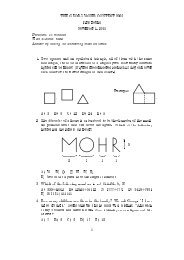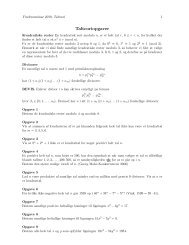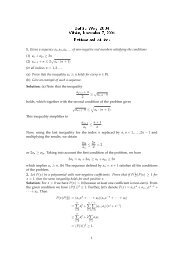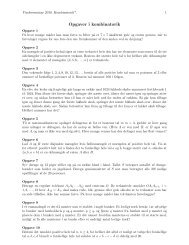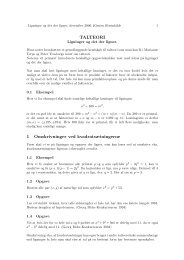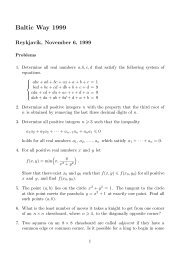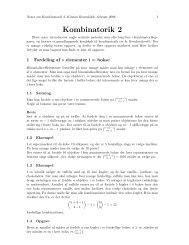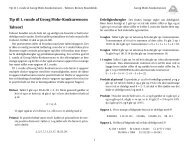14th Nordic Mathematical Contest Solutions Problem 1. Set x = the ...
14th Nordic Mathematical Contest Solutions Problem 1. Set x = the ...
14th Nordic Mathematical Contest Solutions Problem 1. Set x = the ...
Create successful ePaper yourself
Turn your PDF publications into a flip-book with our unique Google optimized e-Paper software.
<strong>14th</strong> <strong>Nordic</strong> <strong>Ma<strong>the</strong>matical</strong> <strong>Contest</strong><br />
<strong>Solutions</strong><br />
<strong>Problem</strong> <strong>1.</strong> <strong>Set</strong> x = <strong>the</strong> number of sums with 3 different integers, y = <strong>the</strong> numbers of<br />
sums with 2 different integers. Consider a sequence of 3999 numbered boxes where every<br />
odd-numbered box contains a red ball. Every placement of blue balls in( any two ) of <strong>the</strong> evennumbered<br />
boxes produces a division of 2000 in three parts. There are = 999 · 1999<br />
1999<br />
2<br />
ways of placing <strong>the</strong> two balls. Now every division of 2000 in three parts of different size<br />
is produced by 3! = 6 different placements, and every division having two equal parts<br />
is produced by 3 different placements. So 6x + 3y = 1999 · 999. But y = 999, since<br />
<strong>the</strong> two equal parts can assume any size from 1 to 999. Solving, we get x = 998 · 333,<br />
x + y = 1001 · 333 = 333333.<br />
<strong>Problem</strong> 2. Assume P n originally has m coins, P n−1 m + 1 coins, . . . , P 1 m + n − 1<br />
coins. In every move, a person receives k coins and gives k + 1 coins, so in total his fortune<br />
diminishes by one coin. After <strong>the</strong> first round, when P n has left n coins to P 1 , P n has m − 1<br />
coins, P n−1 has m coins, etc., after two rounds P n has m − 2 coins, P n−1 has m − 1 coins,<br />
etc. We can continue like this for m rounds, and after that P n has no money, P n−1 has<br />
one coin etc. Now in round m + 1 every person who has money can receive money and<br />
give away money as before, except P n who was bankrupt. He receives n(m + 1) − 1 coins<br />
from P n−1 , but cannot give n(m + 1) coins away. In this situation P n−1 has one coin,<br />
and P 1 has n − 2 coins. The only pair of neighbors where one player can have 5 times<br />
as many coins as <strong>the</strong> o<strong>the</strong>r is (P 1 , P n ). Because n − 2 < n(m + 1) − 1, we must have<br />
5(n − 2) = n(m + 1) − 1 or n(4 − m) = 9. Since n > 1, ei<strong>the</strong>r n = 3, m = 1 or n = 9,<br />
m = 3. Both alternatives work: in <strong>the</strong> first case, <strong>the</strong> number of coins is 3 + 2 + 1 = 6, in<br />
<strong>the</strong> second, 11 + 10 + · · · + 3 = 63.<br />
<strong>Problem</strong> 3, solution <strong>1.</strong> Consider triangles AOE and AOD. They have two equal<br />
sides, and equal angles opposite to one pair of equal sides. Then ei<strong>the</strong>r AOE and AOD<br />
are congruent or ̸ AEO = 180 ◦ − ̸ ADO. In <strong>the</strong> first case, ̸ BEO = ̸ CDO, and <strong>the</strong><br />
triangles EBO and DCO are congruent. Altoge<strong>the</strong>r, <strong>the</strong>n, AB = AC. In <strong>the</strong> second<br />
case, denote <strong>the</strong> angles at A, B, and C by 2α, 2β, and 2γ, respectively, and ̸ AEO by δ.<br />
Using <strong>the</strong> <strong>the</strong>orem of <strong>the</strong> adjacent angle in a triangle,we get ̸ BOE = ̸ DOC = β + γ,<br />
δ = 2β + γ, 180 ◦ − δ = β + 2γ. Adding <strong>the</strong>se,we have 3(β + γ) = 180 ◦ , β + γ = 60 ◦ .<br />
Combining this with 2(α + β + γ) = 180 ◦ , we get 2α = 60 ◦ .<br />
<strong>Problem</strong> 3, solution 2. Let β, γ be as above. Using <strong>the</strong> sine <strong>the</strong>orem in △BEO and<br />
△CDO, we obtain<br />
OE<br />
sin β =<br />
OB<br />
sin(180 ◦ − 2β − γ) ,<br />
OD<br />
sin γ =<br />
OC<br />
sin(180 ◦ − β − 2γ) .<br />
These combine to<br />
OB<br />
OC<br />
=<br />
sin(2β + γ) sin γ<br />
sin(β + 2γ) sin β .
Using <strong>the</strong> <strong>the</strong>orem of sines to △BOC, we obtain<br />
OB<br />
OC = sin γ<br />
sin β .<br />
So we must have sin(β + 2γ) = sin(2β + γ). So ei<strong>the</strong>r β + 2γ = 2β + γ or β + 2γ =<br />
180 ◦ − 2β − γ. The first equation implies β = γ, or <strong>the</strong> isosceles case, while <strong>the</strong> second one<br />
gives β + γ = 60 ◦ , which easily leads to ̸ BAC = 60 ◦ .<br />
<strong>Problem</strong> 4. Assuming 0 ≤ x < y < z ≤ 1 and y − x = z − y, we have<br />
f(z) − f(y) ≤ 2f(y) − 2f(x)<br />
f(y) − f(x) ≤ 2f(z) − 2f(z) − f(y),<br />
or<br />
2<br />
3 f(x) + 1 3 f(z) ≤ f(y) ≤ 1 3 f(x) + 2 f(z). (1)<br />
3<br />
Denote f ( (<br />
1<br />
3)<br />
by a and f<br />
2<br />
) 1<br />
3 by b. Apply (1) with x = 0, y =<br />
3 , z = 2 3 , and x = 1 3 , y = 2 3 ,<br />
and z = 1, to obtain<br />
1<br />
3 b ≤ a ≤ 2 3 b<br />
2<br />
3 a + 1 3 ≤ b ≤ 1 3 a + 2 3 .<br />
Eliminating b, we have<br />
(<br />
1 2<br />
3 3 a + 1 )<br />
≤ a ≤ 2 ( 1<br />
3 3 3 3)<br />
a + 2 ,<br />
fron which one solves for a to obtain 1 7 ≤ a ≤ 4 . – In fact, <strong>the</strong> bounds cannot be reached;<br />
7<br />
one can show that <strong>the</strong> sharp bounds for f( 1 3 ) are 4<br />
27<br />
and<br />
76<br />
135 .


